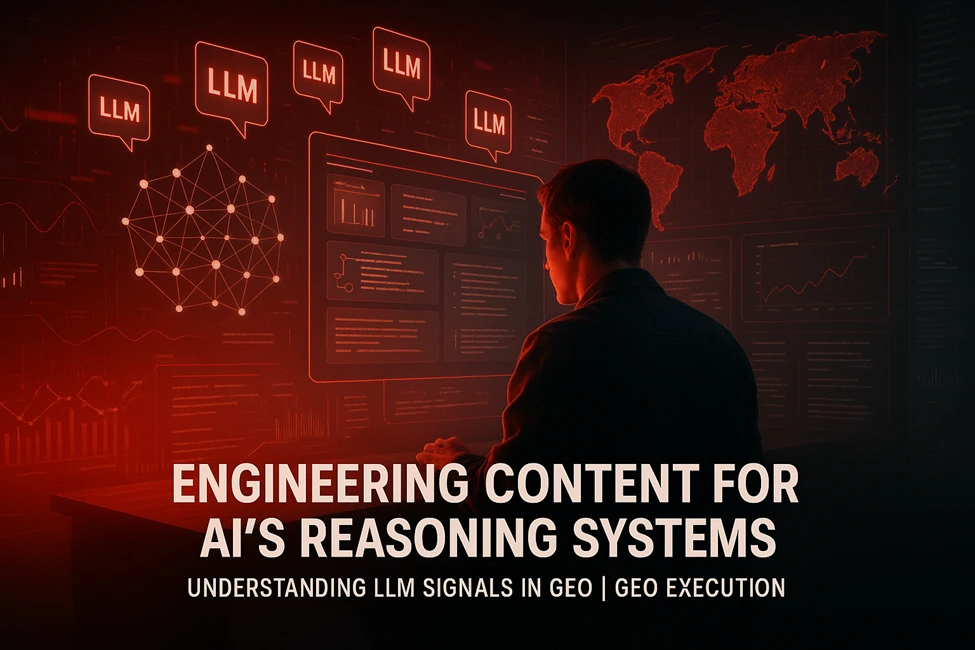Engineering Content for AI's Reasoning Systems: Understanding LLM Signals in GEO

The digital marketing world is in the middle of a seismic shift. For years, the game was simple: get your website to the top of Google’s ten blue links. But today, when you ask Google a question, you often don’t get a list of links at all. You get a direct, synthesized answer, crafted by Artificial Intelligence. This is the new reality of search, and it’s changing everything.
For business leaders and marketing professionals, this isn't just another algorithm update. It's a fundamental change in how customers discover brands. The old rules of SEO are no longer enough to guarantee visibility. The new goal isn't just to be on the results page; it's to be the result itself.
This is the world of Generative Engine Optimization (GEO). It requires a new way of thinking not about keywords and backlinks, but about clarity, control, and structure. It’s about engineering your content to be understood, trusted, and cited by AI reasoning systems. This guide will break down how these AI models "think" and provide a clear playbook for structuring your content to win in the age of AI search.
The New Digital Landscape: An Introduction to GEO
Before we dive into the "how," let's clarify the "what." Generative Engine Optimization (GEO) is the practice of optimizing your brand's scope and digital presence to be sourced, cited, or summarized directly within the answers provided by AI-driven search engines like Google's AI Overviews, ChatGPT, and Perplexity. Your content doesn't just lead to a click; it becomes a foundational piece of the information the user receives.
It's crucial to distinguish this from an older marketing term, "geo-targeting," which focuses on reaching users based on their physical location. While still important, our focus here is on optimizing for the AI engines that are redefining information discovery itself.
Is GEO the New SEO?
This is a common question, and the answer is an absolute no. GEO does not replace Search Engine Optimization (SEO); it elevates it. Think of it this way:
- SEO is your foundation: It ensures your website is technically sound, discoverable, and relevant to traditional search crawlers.
- GEO is your authority: It's the strategy you build on that foundation to prove to sophisticated AI models that your content is not just discoverable, but trustworthy enough to be used as a source for a direct answer.
Both are essential, but GEO requires a deeper understanding of how AI models reason and what signals they use to determine truth and authority.
How AI "Thinks": A Look Inside the Mind of an LLM
To engineer content for an AI, you first need to understand how it processes information. Large Language Models (LLMs) the technology behind tools like Gemini and ChatGPT don't "search" in the traditional sense. They reason. Unlike old search engines that matched keywords to documents, LLMs are designed to understand meaning, context, and intent. When you enter a query, a multi-step process begins:
- Deconstruction and Intent Analysis: The LLM breaks your query down into smaller pieces called "tokens." It then uses complex algorithms to build a semantic map, trying to understand what you are really asking, including the nuance, tone, and underlying goal.
- Information Retrieval: The model then decides if it can answer from its vast training data alone or if it needs fresh, real-time information. For most queries, it performs the latter. Using a process called Retrieval-Augmented Generation (RAG), the LLM accesses external sources primarily by running multiple, refined searches on engines like Google and Bing.
- Synthesis and Generation: The LLM gathers information from numerous web pages, considers them for credibility, and synthesizes the key points into a single, coherent answer. It's not just copying and pasting; it's actively reading, comparing, and summarizing information from the sources it deems most reliable.
This process reveals a critical truth for marketers: your content is being read and judged by a machine. To be chosen as a source, your content must send all the right signals of quality and trustworthiness.
The Signals That Matter: What LLMs Look for in Your Content
LLMs are trained to identify patterns that correlate with high-quality, trustworthy information. Engineering your content for GEO means intentionally implanting these signals into your work. These signals fall into three main categories.
1. Structural and Semantic Clarity
An LLM needs to parse your content quickly and efficiently. Confusing, cluttered, or poorly organized content is likely to be ignored.
- Hierarchical Headings: Use a logical structure with H1, H2, and H3 tags. This acts as a roadmap, helping the AI understand the relationship between different concepts on the page.
- Answer-First Formatting: Start your articles and key sections with a direct, concise answer to the main question (the "inverted pyramid" method). This makes it easy for the AI to extract a definitive summary.
- Scannable Content: Break down complex topics into short paragraphs, bulleted lists, numbered steps, and tables. This creates clean, quotable segments that are easy for an AI to lift and cite.
- Question-Based Headings: Frame your subheadings as the questions your audience is asking. This directly aligns your content with the conversational queries common in AI search.
2. Authority and Trustworthiness (E-E-A-T)
AI models are designed to be skeptical. They cross-reference information and look for proof that your content is credible. The principles of E-E-A-T (Experience, Expertise, Authoritativeness, and Trustworthiness) are more critical than ever.
- Factual Accuracy and Citations: Back up your claims with data. Link out to authoritative sources like government studies, academic research, and industry leaders. This shows the AI that your information is well-researched.
- Originality and First-Hand Experience: Content that includes original data, unique insights, case studies, or real-life examples signals actual expertise. This helps an LLM differentiate your content from generic, rewritten information.
- Consistent Phrasing: Define key concepts related to your brand or industry using the same clear, concise language across your website and other platforms (like partner sites or review profiles). This helps the LLM build a consensus and recognize your definition as the standard.
- Topical Authority: Don't just write one article on a topic. Build content clusters a main "pillar" page linked to several in-depth "spoke" pages to demonstrate comprehensive knowledge on a subject. This signals to the AI that you are a go-to resource.
3. Technical Readiness
Behind the scenes, your website's technical setup can either help or hinder an AI's ability to access and understand your content.
- Structured Data (Schema Markup): Schema is code that explicitly tells AI systems what your content is about (e.g., this is an FAQ, this is a How-To guide, this is a product). It removes ambiguity and is a powerful signal for GEO.
- Clean, Accessible Code: AI crawlers prefer simple HTML and can struggle with content that relies heavily on complex JavaScript to load. A fast, mobile-friendly site is essential.
- Emerging Standards like: A new, proposed standard called allows you to create a file that acts as a curated map for AI crawlers, pointing them directly to your most important, machine-readable content.
The Public Media Solution Playbook for GEO Execution
Understanding the theory is one thing; placing it into practice is another. Here is a step-by-step process to start engineering your content for AI reasoning systems.
Step 1: Conduct a GEO Content Audit
Before creating new content, analyze your existing assets through an AI lens. Go through your key pages and ask:
- Is it Citable? Does the page contain clear, concise definitions or data points that an AI could easily quote?
- Is it Structured? Does it use clear headings, lists, and short paragraphs?
- Is it Authoritative? Is it supported by evidence and links to credible sources?
- Is it Answer-First? Does the most essential information appear at the top of the page or section?
This audit will help you identify low-hanging fruit—pages that can be quickly updated to nicely align with GEO principles.
Step 2: Structure Content with the B-SMART Framework
When creating new content, especially for products or services, use a framework that ensures you cover all the key entities an AI needs to understand. The B-SMART framework is a simple checklist for this :
- Brand: Is the brand name clearly stated?
- Shape/SKU: Are specific versions, sizes, or model numbers mentioned?
- Materials: What is it made of? What technology does it use?
- Area of Industry: Who is this for? Which sector does it serve?
- Requirements: What is needed to use it? Are there any prerequisites?
- Type: What category of product or service is this?
Structuring your descriptions this way provides a rich, detailed profile that is easy for an LLM to parse and use in comparisons or recommendations.
Step 3: Write for Humans, but Structure for Machines
The core of GEO is not about writing robotic content. It's about presenting helpful, human-centric information in a highly organized way.
- Use Conversational Language: Write in an honest style that mirrors how individuals actually speak and ask questions.
- Implement Schema Markup: Work with your development team to add relevant structured data to your key pages. Prioritize schema types like FAQPage, HowTo, Article, and Product.
- Build Topic Clusters: Plan your content calendar around topic clusters, not just isolated keywords. This demonstrates deep expertise and builds the topical authority that LLMs reward.
The Future is Now: Why GEO is Non-Negotiable
The shift from a list of links to a direct answer is not a trend; it is the future of search. Users are getting accustomed to faster, more direct access to information, and the platforms are evolving to meet that demand.
Brands that cling to old SEO tactics alone risk becoming invisible. The winners in this new generation will be those who embrace GEO not as a set of tricks, but as a commitment to completing clear, authoritative, and impeccably structured content. By engineering your content to be understood by AI, you are ultimately creating a better, more helpful experience for your human audience. You are not just optimizing for an algorithm; you are building a foundation of digital trust that will pay dividends for years to come.
If you're ready to adapt your strategy and position your brand as an authority in the age of AI, contact Public Media Solution today. Let's engineer your content for the future of search.
Share
Table Of Contents
- The New Digital Landscape: An Introduction to GEO
- How AI "Thinks": A Look Inside the Mind of an LLM
- The Signals That Matter: What LLMs Look for in Your Content
- The Public Media Solution Playbook for GEO Execution
- The Future is Now: Why GEO is Non-Negotiable
